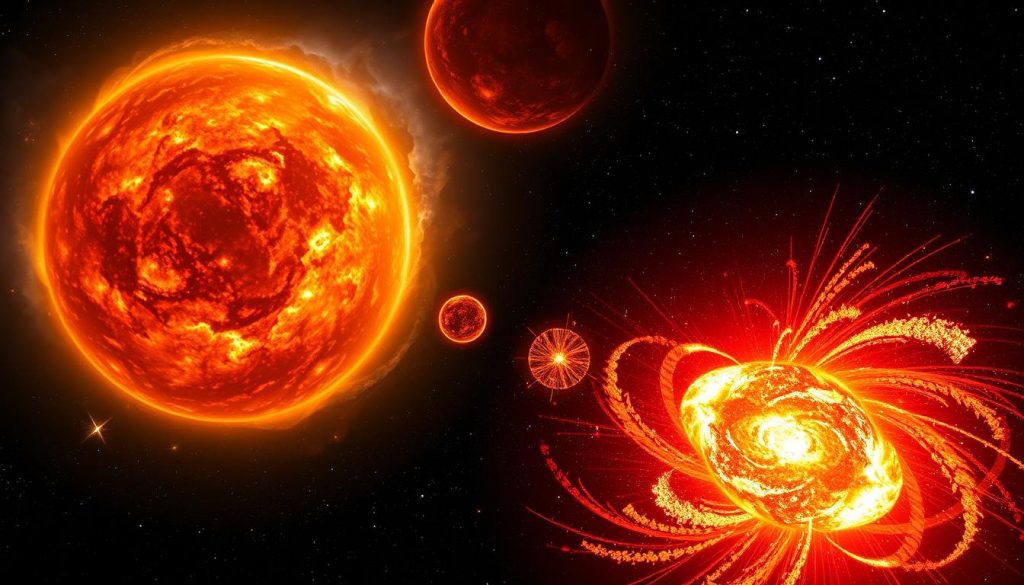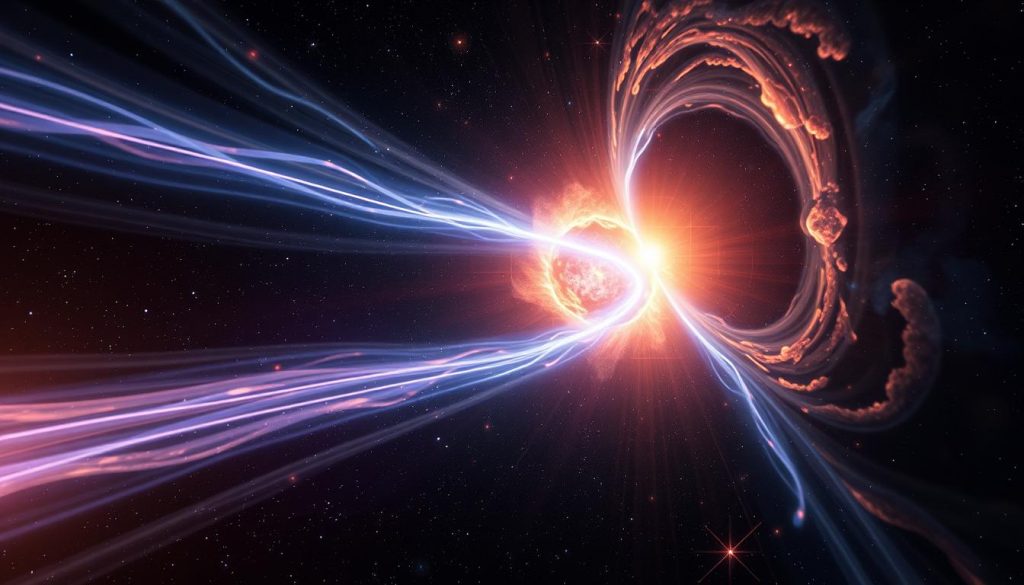Why supernovas leave light echoes visible for centuries.
Supernovas are among the most spectacular cosmic events. They shine brightly, echoing through space like a canyon echo. These massive star explosions light up the sky and create light echoes. This aftereffect happens when the energy scatters and reflects off nearby matter.
Anúncios
The echoes can reach our telescopes from *minutes to millennia* after the explosion. This gives astronomers a rare chance to study these events. They can learn a lot about stars and the universe from these echoes.
For example, light echoes from gas clouds near Sagittarius A, our galaxy’s black hole, show it was more active *200 years ago*. The Vera C. Rubin Observatory, set to launch in January 2025, will help scientists study these echoes. This will help us understand how supernovae interact with their surroundings over time.
The Phenomenon of Supernovas
A supernova is one of the most amazing cosmic events. It marks the end of a star’s life. The explosion can shine brighter than whole galaxies, making supernovas incredibly bright.
About two to three supernovas happen each century in galaxies like ours. Astronomers see hundreds more outside our galaxy every year.
Supernovas come in two types: core-collapse and thermonuclear. Core-collapse happens when massive stars run out of fuel and collapse. This explosion sends the star’s outer layers into space, enriching the universe with new elements.
Thermonuclear supernovae occur when white dwarfs grow too heavy. They reach a point where they can no longer support their own weight.
These explosions are key to creating heavy elements like gold and uranium. They also produce carbon and nitrogen, vital for life. A lot of the universe’s iron is made in these star explosions.
The leftovers of supernovas, like the Crab Nebula, offer insights into what happens after a supernova. These remnants expand fast, creating areas with strong magnetic fields and hot plasma. This can lead to shock waves.
The Lifecycle of a Star Leading to a Supernova
Every star has a journey that ends in a supernova. It starts with nuclear fusion in its core, lasting millions of years. This process turns hydrogen into helium, releasing light and heat.
Massive stars go through more stages, creating elements like oxygen and nitrogen. They eventually make iron.
When a star runs out of fuel, big changes happen. Stars five times bigger than our Sun can get hotter than 100 billion degrees. This heat causes a collapse that leads to a supernova.
This explosion releases more energy than the star did in its whole life. About 25% of the star’s mass is spread into space, enriching the cosmos.
After a supernova, what’s left decides the star’s fate. If it’s between 1.4 and 3 times the Sun’s mass, it becomes a neutron star. More than that, and it turns into a black hole.
Supernovas are key to the universe. They help create new elements, making planets and life possible. Every ten seconds, a supernova happens, showing the cycle of life and death in the stars.

How Supernovas Create Light Echoes
Supernova explosions send out a huge burst of light into space. This light hits clouds of cosmic dust and bounces back, creating light echoes. This is similar to how sound waves bounce off surfaces, but with light.
The path of light gets longer because of the materials it meets in space. The distance and density of these materials affect how long it takes for the light echoes to reach us.
The light echo from supernova SN 2009ig is a great example. It was seen just a day after the explosion. It’s the brightest light echo from a type Ia supernova, about 127 million light-years away.
People started watching it in 2010, even though it was much dimmer by then. This shows how light echoes can stay visible for a long time after a supernova.
By studying these light echoes, scientists can learn more about the original explosion. They can also understand the astrophysical phenomena around it. The patterns in these echoes give clues about the types of stars that explode in supernovae.
Historical Observations of Supernova Light Echoes
For centuries, supernovas have left a mark on the sky, especially through light echoes. Tycho’s supernova in 1572 is a prime example. It was so bright, it outshone Venus and was seen in daylight for weeks. Even today, light from this event still gives us clues about the past.
Light echoes from supernovas can last for centuries. Tycho’s supernova is a key example. It lets scientists study the explosion and its surroundings. For example, light echoes from SN 1987A have been tracked for 22 years, helping us understand how the supernova expanded.
Only seven supernovas have been spotted in the last 2000 years. These events are rare but crucial. They help us learn about the creation of heavy elements like calcium and iron on Earth.
Other supernovas, like Cassiopeia A from 1671, have also left their mark. Modern telescopes have studied these light echoes. Projects like Pan-STARRS and LSST will help us learn even more about supernovas.
Scientific Importance of Studying Light Echoes
Studying light echoes gives us a deep look into the universe. They act as windows into cosmic history. This lets astronomers learn about supernova explosions and the space they travel through.
These studies help us understand the astrophysical significance of elements made in stars. For example, type-Ia supernovae, like SN1572, are like ‘standard candles.’ They help measure how far away things are and how fast the universe is expanding.
Using advanced telescopes, like the 8.2 m Subaru telescope in Hawaii, we can see these light echoes. This gives us information that supernovae remnants alone can’t. It helps us learn about the explosion’s details, like how fast calcium ions moved.
As we keep studying light echoes, we uncover stories of the universe’s past. This helps us improve our understanding of how the universe expands and how stars live and die.
Modern Techniques for Detecting Light Echoes
Technology has changed how we find light echoes in space. Astronomers use new imaging methods to spot tiny changes in light. These methods help us see faint arcs of light from old supernovae.
The James Webb Space Telescope (JWST) has made a big discovery. It found light echoes near Cassiopeia A, a supernova remnant 11,000 light-years away. This light started its journey 350 years ago. JWST caught these echoes three times in three weeks, showing its skill.
Light echoes in infrared are rare because they need special supernovae. The Nancy Grace Roman Space Telescope, launching in 2027, will help us learn more. It will look at more of the universe, finding more light echoes.
The JWST has shown us the universe’s complex structure. It sees layers and knots in space, like *knots in a wood grain*. This helps us understand the three-dimensional space around us. It will change how we study the universe.
| Telescope | Type | Aperture Size | Purpose |
|---|---|---|---|
| James Webb Space Telescope | Infrared Observatory | 6.5 meters | Light echo detection and interstellar studies |
| Keck I Telescope | Optical/Infrared | 10 meters | High-quality spectra measurements |
| Mayall 4-meter Telescope | Optical | 4 meters | Light echo measurements |
Advanced telescopes and new imaging methods are key. They help us find light echoes and learn about supernovae. This opens up new areas of study.

Implications of Supernova Light Echoes on Cosmology
The study of supernova light echoes is key to understanding the universe. It helps us learn about stars and how far away galaxies are. By studying these echoes, scientists can figure out how fast the universe is expanding.
Supernovae, especially Type Ia, are like “standard candles” for astronomers. Their consistent brightness lets us measure distances very accurately. This is crucial for understanding the universe’s scale.
For example, Cassiopeia A is a supernova remnant 11,000 light-years away. Its explosion’s light reached Earth 300 years ago. This gives us clues about its formation conditions.
Studying Cassiopeia A has led to over 1,000 scientific papers. It shows how important it is for cosmology.
Supernovae also help us understand dark energy. They show how the universe is speeding up. By analyzing light echoes, scientists can learn more about dust around these events.
Light echoes from supernovae can take years or even centuries to reach us. They offer a unique chance to study the universe. By looking at these echoes, we learn more about the universe’s past and its future.
Conclusion
Supernovas are huge events in the life of stars that change our view of the universe. Their bright explosions mark the end of a star’s life. They also send out light echoes that help scientists understand the universe’s past.
Events like Supernova 1987A, 150,000 light-years away, and the fading light from NGC 2525, 70 million light-years away, show us how much we can learn. These observations help us see the universe’s history in detail.
Supernovas are like standard lights that help us measure how far away things are. This lets us see how fast the universe is growing. By studying these explosions, scientists learn about the universe’s beginnings.
As we get better at detecting supernovas, we’ll learn even more about the universe. These events happen about every 50 years. They give us a glimpse into the universe’s secrets, making us appreciate our place in it.
